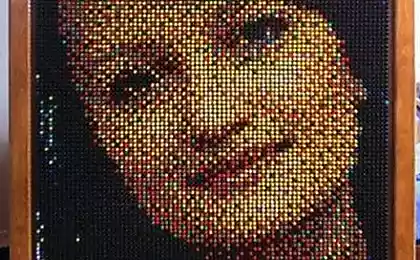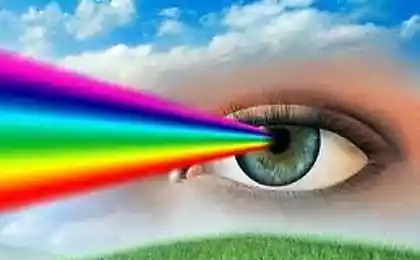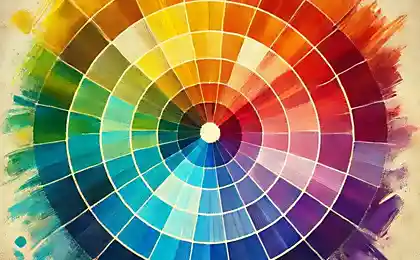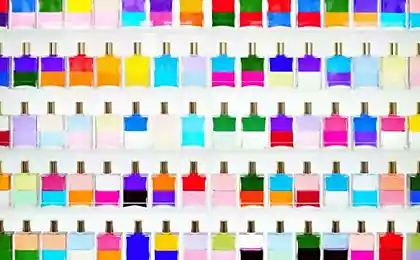704
5 things that will change your perception of color perception
On the difficult relationship of people and ottenkov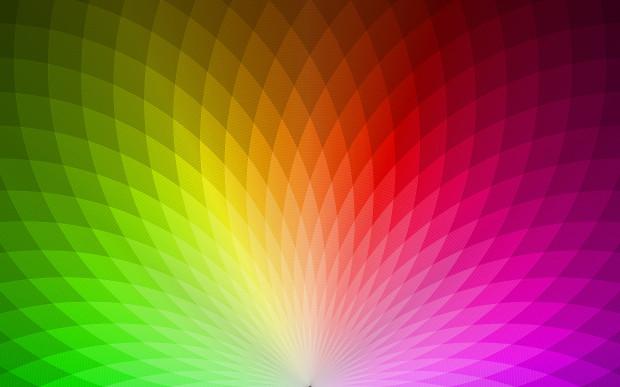
you ever wondered about your perception of the color of what you see different shades of the world? "What is there to think - that red, blue yonder, but it is certainly green, nothing interesting" - and the answer you will be wrong. Color perception is a complex psychophysiological process, some features of which are still not fully understood by scientists. We offer you five interesting facts that can make your palette more diverse picture of the world, and the perceived colors - bright and saturated.
1. In some languages, different colors designated one slovom
Residents of Japan, referring to the blue or green, call them by the same word "ao" (Jap. 青青 い), so explain to the Japanese in their own language, what is the difference between the two tones, it will be difficult - many ( particularly the older generation) do not distinguish between these colors.
Until the American occupation of Japan after World War II for its citizens there was no difference between blue and green, but gradually the situation changed. The Japanese have borrowed some English words to enrich their dialects, including the notion of designating color - so the British «blue» was «buryu» (Jap. ブ リ ュ), resulting in a new generation began to distinguish between blue and green, although there is still such allowing traffic signal in Japan instead of the green, as in most countries, can be blue.
A similar situation with the names of colors observed in some other languages - for example, in the dialect of one of the tribes of New Guinea, blue and green as well as Japanese-be labeled, Vietnamese are no clear boundaries between the designation of red, orange and yellow, while the nation tribute, originally from the western edge of the island of New Guinea, and at all there are only two words that describe the color - the "dark" and "light».
2. In the Middle Ages cosmetics made from Egyptian mumiy
Nowadays, women are paying great attention to the composition of the cosmetics they use. Most modern cosmetic companies produce components of its products in a sterile, almost laboratory conditions, however, was not always so - say, medieval master cosmetics cases, to create a bright shade of color that would have liked the European capricious women of fashion, trying to find exotic ingredients one another. In the course were minerals, rare plants, crushed insects, animal products, such as pounded antlers or bull semen ... and even human remains.
European merchants of the time of the late Middle Ages brisk trade brought from Egypt mummies. From the customers did not rebound - the doctors did not get tired to extol the beneficial properties of miracle drugs containing mummified human flesh. Later it came to the fact that from the remains began to produce a brown dye that, among other things, included in the composition of cosmetic products - in other words, European mods aristocrats decorated their faces withered corpses of Egyptian nobility.
This practice persisted for several centuries, but over time people began to understand that trade is not dead too ethically and export of mummies from Egypt banned. More than any other of such sanctions affected not only the manufacturers of cosmetics, but also artists - it was rumored that some of them even had to hide the original "tubes with brown paint" from prying eyes.
3. People can see nonexistent tsveta
You probably know that the phenomenon of color perception exists only in our heads, and reaching the brain information about the colors is limited to the capabilities of our eyes.
In view of human organs for color perception meet the so-called cones - one of the types of photoreceptors. There are three types of cone cells, each sensitive to a different range of light waves - one responsible for the violet-blue portion of the visible spectrum, the other for the greenish-yellow, and some of the yellow-red.

Due to the nature of the brain, we can not perceive shades, combining opponentnye colors such as blue and yellow, green and red, white and black - in our minds they are "mixed", so in the first case we see green, the second brownish brown, and gray in the third. Employees of Stanford University in one experiment found a way to fool the color perception of the participants, with the result that the volunteers were able to see the so-called "impossible" shades. To understand what is at stake, a few minutes carefully observe the alternation of yellow circles and black squares - at some point you will probably see the "impossible" saturated bluish-black color called "Blue Stygian».
4. What color is the universe? 14,873,256
In 2002, a group of American scientists from Johns Hopkins University, analyzed data on light characteristics of more than 200 thousand galactic systems received their Australian counterparts, found that the overall color of the entire universe can be regarded as beige (light taupe) - such color resulting in color mixing of the sample galaxies.
After making the discovery of a truly epochal importance could only give a "universal color" something sonorous name, and it was found - a shade called "space coffee with milk».
5. Humanity is indebted to golubymi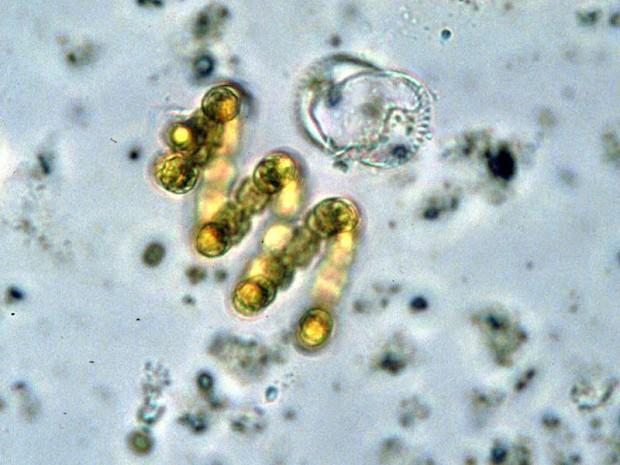
What do you associate the color blue? Most likely, the most popular answers will be the sky or the sea, and no one thinks of cyanobacteria - blue-green algae, which are the most important form of life on our planet. These microorganisms, painted in various shades of blue (in the lane. From the Greek. «Cyanus» means "blue"), during their life on earth they created conditions that contributed to the evolution and emergence of other living organisms.
Firstly, cyanobacteria most directly involved in the process of nitrogen fixation, i.e. the separation of nitrogen from air and formation of nitrogen compounds suitable for use by plants and other life forms. Secondly, it is the cyanobacterium about 2, 4 billion years ago formed the Earth's atmosphere in the form in which we know it today (except for the different "ingredients" that are released into the atmosphere by industry and cars). Third, they enrich the soil valuable substances, such as amino acids and vitamins, as otmiraya, cyanobacteria themselves become part of the soil and rocks. The list goes on for a long time - the role of cyanobacteria in nature can not be overestimated. Without them there would be no plants, no animals, no people, no computers nor this collection, so you can tell people all that they have, are obliged blue bacteria.
via factroom.ru

you ever wondered about your perception of the color of what you see different shades of the world? "What is there to think - that red, blue yonder, but it is certainly green, nothing interesting" - and the answer you will be wrong. Color perception is a complex psychophysiological process, some features of which are still not fully understood by scientists. We offer you five interesting facts that can make your palette more diverse picture of the world, and the perceived colors - bright and saturated.
1. In some languages, different colors designated one slovom

Residents of Japan, referring to the blue or green, call them by the same word "ao" (Jap. 青青 い), so explain to the Japanese in their own language, what is the difference between the two tones, it will be difficult - many ( particularly the older generation) do not distinguish between these colors.
Until the American occupation of Japan after World War II for its citizens there was no difference between blue and green, but gradually the situation changed. The Japanese have borrowed some English words to enrich their dialects, including the notion of designating color - so the British «blue» was «buryu» (Jap. ブ リ ュ), resulting in a new generation began to distinguish between blue and green, although there is still such allowing traffic signal in Japan instead of the green, as in most countries, can be blue.
A similar situation with the names of colors observed in some other languages - for example, in the dialect of one of the tribes of New Guinea, blue and green as well as Japanese-be labeled, Vietnamese are no clear boundaries between the designation of red, orange and yellow, while the nation tribute, originally from the western edge of the island of New Guinea, and at all there are only two words that describe the color - the "dark" and "light».
2. In the Middle Ages cosmetics made from Egyptian mumiy

Nowadays, women are paying great attention to the composition of the cosmetics they use. Most modern cosmetic companies produce components of its products in a sterile, almost laboratory conditions, however, was not always so - say, medieval master cosmetics cases, to create a bright shade of color that would have liked the European capricious women of fashion, trying to find exotic ingredients one another. In the course were minerals, rare plants, crushed insects, animal products, such as pounded antlers or bull semen ... and even human remains.
European merchants of the time of the late Middle Ages brisk trade brought from Egypt mummies. From the customers did not rebound - the doctors did not get tired to extol the beneficial properties of miracle drugs containing mummified human flesh. Later it came to the fact that from the remains began to produce a brown dye that, among other things, included in the composition of cosmetic products - in other words, European mods aristocrats decorated their faces withered corpses of Egyptian nobility.
This practice persisted for several centuries, but over time people began to understand that trade is not dead too ethically and export of mummies from Egypt banned. More than any other of such sanctions affected not only the manufacturers of cosmetics, but also artists - it was rumored that some of them even had to hide the original "tubes with brown paint" from prying eyes.
3. People can see nonexistent tsveta

You probably know that the phenomenon of color perception exists only in our heads, and reaching the brain information about the colors is limited to the capabilities of our eyes.
In view of human organs for color perception meet the so-called cones - one of the types of photoreceptors. There are three types of cone cells, each sensitive to a different range of light waves - one responsible for the violet-blue portion of the visible spectrum, the other for the greenish-yellow, and some of the yellow-red.

Due to the nature of the brain, we can not perceive shades, combining opponentnye colors such as blue and yellow, green and red, white and black - in our minds they are "mixed", so in the first case we see green, the second brownish brown, and gray in the third. Employees of Stanford University in one experiment found a way to fool the color perception of the participants, with the result that the volunteers were able to see the so-called "impossible" shades. To understand what is at stake, a few minutes carefully observe the alternation of yellow circles and black squares - at some point you will probably see the "impossible" saturated bluish-black color called "Blue Stygian».
4. What color is the universe? 14,873,256
In 2002, a group of American scientists from Johns Hopkins University, analyzed data on light characteristics of more than 200 thousand galactic systems received their Australian counterparts, found that the overall color of the entire universe can be regarded as beige (light taupe) - such color resulting in color mixing of the sample galaxies.
After making the discovery of a truly epochal importance could only give a "universal color" something sonorous name, and it was found - a shade called "space coffee with milk».
5. Humanity is indebted to golubymi

What do you associate the color blue? Most likely, the most popular answers will be the sky or the sea, and no one thinks of cyanobacteria - blue-green algae, which are the most important form of life on our planet. These microorganisms, painted in various shades of blue (in the lane. From the Greek. «Cyanus» means "blue"), during their life on earth they created conditions that contributed to the evolution and emergence of other living organisms.
Firstly, cyanobacteria most directly involved in the process of nitrogen fixation, i.e. the separation of nitrogen from air and formation of nitrogen compounds suitable for use by plants and other life forms. Secondly, it is the cyanobacterium about 2, 4 billion years ago formed the Earth's atmosphere in the form in which we know it today (except for the different "ingredients" that are released into the atmosphere by industry and cars). Third, they enrich the soil valuable substances, such as amino acids and vitamins, as otmiraya, cyanobacteria themselves become part of the soil and rocks. The list goes on for a long time - the role of cyanobacteria in nature can not be overestimated. Without them there would be no plants, no animals, no people, no computers nor this collection, so you can tell people all that they have, are obliged blue bacteria.
via factroom.ru
Cardboard figure of Bradley Cooper in full growth accompanies an American everywhere
Creepy smoked carcasses of Papua - New Guinea

